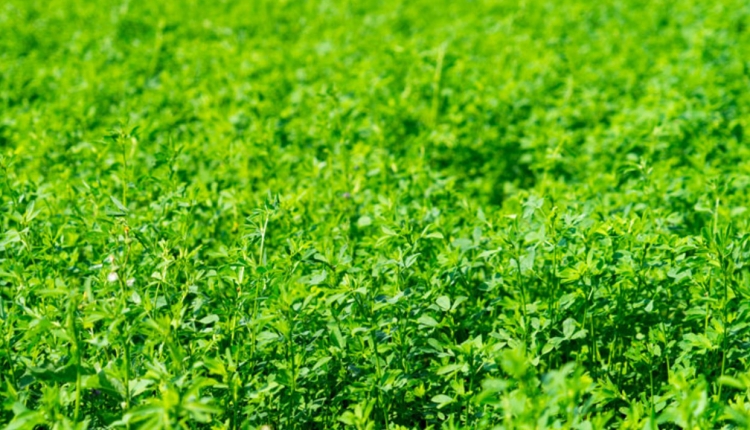Goeser is the director of nutritional research and innovation with Rock River Lab Inc., Watertown, Wis., and adjunct assistant professor, dairy science department, University of Wisconsin-Madison.

Based upon experience, projecting insect or disease pressure is an imperfect science. University of Wisconsin-Madison’s Damon Smith has taught me about the disease triangle; however, having the potential for disease doesn’t necessarily equate to substantial disease.
In years when disease or pest pressure doesn’t amount to much, in hindsight the crop protection investment may seem like an unnecessary cost. We can’t farm in hindsight, though. We also know that in the absence of adequate crop protection measures, the crop is in a susceptible position relative to a sprayed or treated crop.
Worth the investment
With a bit of added investment through crop protection, we ensure our crops have a fighting chance. This was one of the leading discussion points in the June 2022 Feeding Fundamentals column, “Don’t cut corners as possible returns are too great.”
During these unprecedented and volatile economic and global grain supply conditions, we’re growing crops with record value. Yes, input costs are as high as ever. But the crop stands to be of record value and net incredible returns.
In the June column, I described how your farm can economically benefit by ensuring your crops have a chance to achieve their full potential in the field. In this month’s article, let’s transition to thinking about maintaining your crops’ full potential through feedout.
Protection extends to silos
Thanks to Richard Muck, Limin Kung, Chris Wacek-Driver, and other brilliant field-experienced scientists, I have learned a tremendous amount about protecting crops after they’re cut and harvested. Crop protection in the silo is equally important. During invited talks on the subject, I tend to describe the range in success with ensiling crops in tonnage terms. This may not make sense initially, but poor crop protection in the silo equates to substantial fermentation losses and feedout shrink.
Bringing this back to tons, leaning on Kung’s teachings, we can equate 5% to 30% fermentation or feedout shrink to 5 to 30 tons wasted out of every 100 tons harvested from the field. Thinking of fermentation and feedout losses in tonnage terms carries a different impact than imagining carbon dioxide gaseous losses from the pile.
Imagine paying for 5 acres of crop inputs, seed, planting, crop protection, harvesting 100 tons of silage, but only feeding out 85 tons due to 15% shrink through fermentation and feedout. This 5-to-30-ton range lost per 100 tons harvested is an unfortunate reality.
With corn silage prices likely to eclipse $75 per as-fed ton thanks to rising corn prices, economic ramifications associated with poor crop protection in the silo will be staggering. Hence, your farm should focus on both crop protection in the field and now into the silo to optimize your economic performance as harvest for silage comes into season.
Crop protection in the silo comes via several different layers. Physical protection, in the form of plastic or concrete, is important to keep rainwater and oxygen out of the anaerobic silo. Sealing the bunker or pile edges with sand or gravel bags helps here as well. Keeping water out from rain and drainage or pooling is important to help keep negative bacterial growth at bay.
Research-proven oxygen barrier plastics are also important for another crop protection layer, recognizing that air and oxygen are detrimental to fermentation efficiency and feedout stability. Ensure your plastic covers have oxygen permeability data behind them; don’t assume all are created equal. We know that oxygen is detrimental to fermenting feeds and maintaining high-quality silage, from the moment the silo is sealed to the last minute the silage is mixed in the ration.
Packing weight a must
Beyond plastic, packing forage tightly is another way to get oxygen out of your forage and feedout more tons per 100 tons harvested. Upright silos and bags are naturally oxygen limiting provided they’re sealed well, but it’s harder with bunkers and piles, so focus on packing and density. Dry matter or as-fed density, in pounds per cubic foot, are two measures of silage density.
Leading dairies with bunkers and piles are able to achieve 60 pounds as-fed density per cubic foot or greater. The way to get here is to ensure you have at least 800 pounds of tractor weight for every ton of forage coming into the bunker or pile per hour.
Lastly, before your freshly chopped forage hits the silo, there is a potent economic opportunity to protect your crop via research-proven bacterial inoculants or chemical preservatives. Forage fermentation is a fascinating cascade of biological events, but it can go sideways due to many factors.
Much like fungicide or insecticide can improve your crops’ productive potential, research-backed forage preservatives applied at harvest can ensure the fermentation and preservation process proceeds more efficiently. Forage and grain inoculants, including Lactobacillus buchneri, can also improve your crops’ feedout stability and protect from yeast and mold when the feed is re-exposed to air.
There is a wealth of research documenting bacterial inoculants’ and chemical preservatives’ impact on forage quality and dry matter losses. These crop protection tools can equate to an additional 5 to 10 tons or more conserved per 100 tons harvested.
The payback is worth it
All in all, the economics around crop protection from the field to the silo have changed dramatically in 2022. Yes, inputs are more expensive, including plastic and inoculants.
However, the economic downfall associated with an unprotected crop is greater than ever. Preserving another ton of feed has double the return for your dairy relative to a couple of years ago. Ensure your dairy carries your crop protection mindset from the field into the silo this upcoming harvest season, and protect and preserve your increasingly valuable tons to feedout over this next year.











